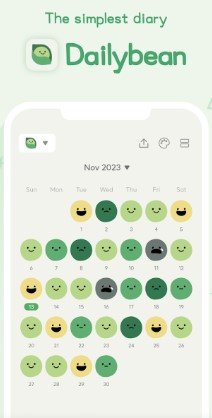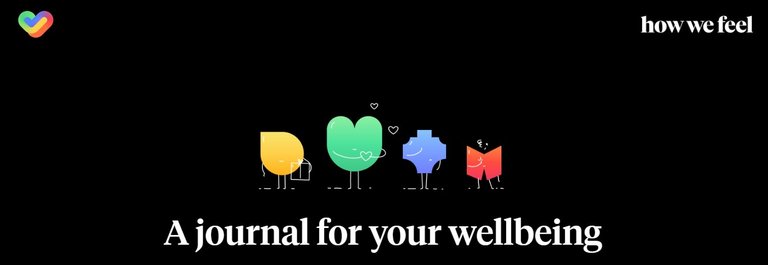Puedes leerlo aquí, o simplemente desplázate hacia abajo en la página.
Hello friends, I hope you're having a happy and productive day. I'm back to write a bit more about one of the topics I'm passionate about and haven't written about in a while: personal growth and productivity.
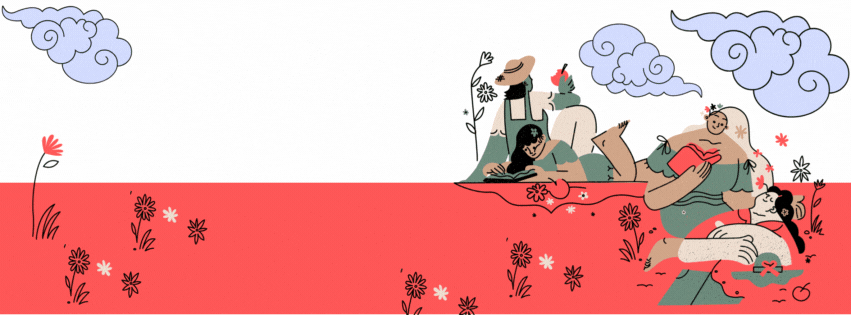
Our world moves faster every day, and everything is governed by immediacy and responses to hundreds of stimuli coming from all sides. Sometimes, in that fast-paced vortex, we forget the importance of focusing on ourselves and the often-overlooked emotions. Sitting down to reflect on what we feel sometimes seems like a luxury we can't afford.
Some time ago, I discovered the benefits of keeping an emotion journal, and I’d like to share these with you. By keeping an emotion journal, I found a useful tool to get to know myself better and understand how I react to different stimuli throughout the day. Moreover, it’s a fun activity that doesn't require much time; five minutes will be more than enough.

Gradually, you'll discover your patterns, the origins of negative emotions, and gain much self-awareness and mental clarity. I can even assure you that it will be a great tool for managing anxiety and stress, releasing all accumulated emotions and facing situations more effectively.
Keeping an emotion journal will also give us extensive communication skills and improve how we convey our feelings to others. We will foster great creativity over time, expressing our feelings on paper and opening ourselves up to a new form of artistic expression where innovative ideas develop.
How to Keep an Emotion Journal
There are several options for having our Emotion Journal handy, both digital and physical. Throughout this article, I'll try to cover both. The first thing you'll need is a notebook and a pen if you choose the traditional method. If you prefer to use a digital method, I'll leave some recommendations later on.
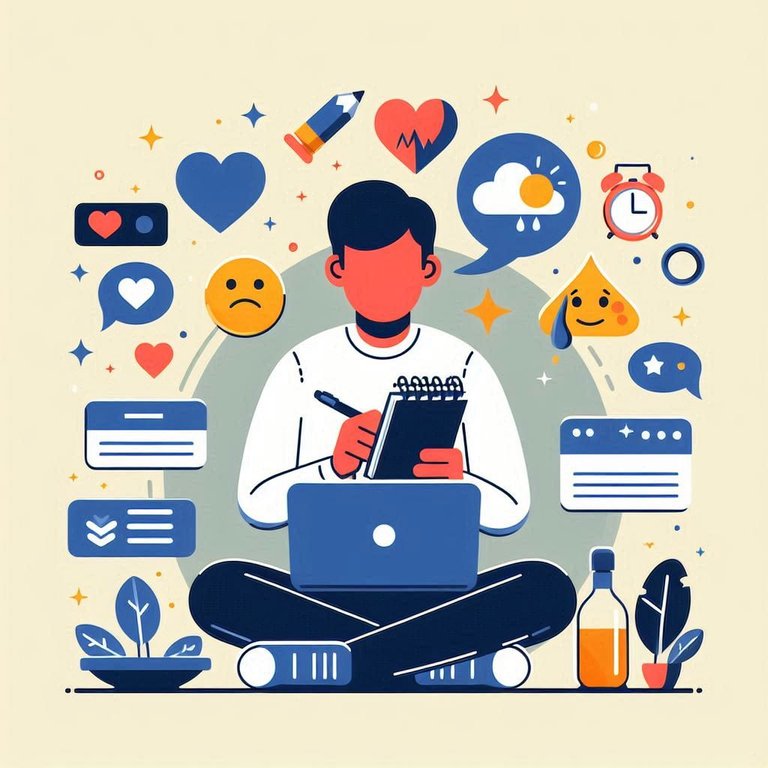
Note: If you decide to use the traditional method, I recommend decorating your Emotion Journal as you like. You can add stickers, nice notes, quotes, drawings... Anything that makes it feel more personal.
- Set a time just for your emotions: You can start with a short amount of time; 5 minutes is a very good start. The important thing is not so much the place but the peace to reflect. Times I recommend are in the morning or at night to have a good overview of the day.
- Describe what you feel: Don't limit yourself to simple emotions like happy, sad, excited. Take your time to describe each emotion in a few words and, if you recognize the triggers, add them. Also, naming the activities or the type of company during the moment you felt the emotion can help us discover patterns in our feelings.
- Honesty: Honesty and staying open and unfiltered is very important. Remember, only you will read this journal. Allow yourself total sincerity while writing; this will be a great key to understanding your emotions. Don't judge yourself in this moment and let yourself flow.
- Don’t focus only on the negative: One of the main mistakes I made when I started was focusing only on negative emotions. This made my Emotion Journal, for a few months, have the opposite effect I expected. Look for that happy moment of the day, no matter how small it is: a cup of coffee, a moment of relaxation, a song while you were on your way to work. This will help you have a more balanced view of the day and reflect on the things that truly matter to you. Something that helped me a lot was writing three things I was grateful for.
- Visualize: Add diagrams, photos, drawings, doodles; any visual content will help you better capture your emotions and create relationships between them. For example, little doodles of the weather, lists of plans, labels of objects and places. Try to relate all this to your emotions.
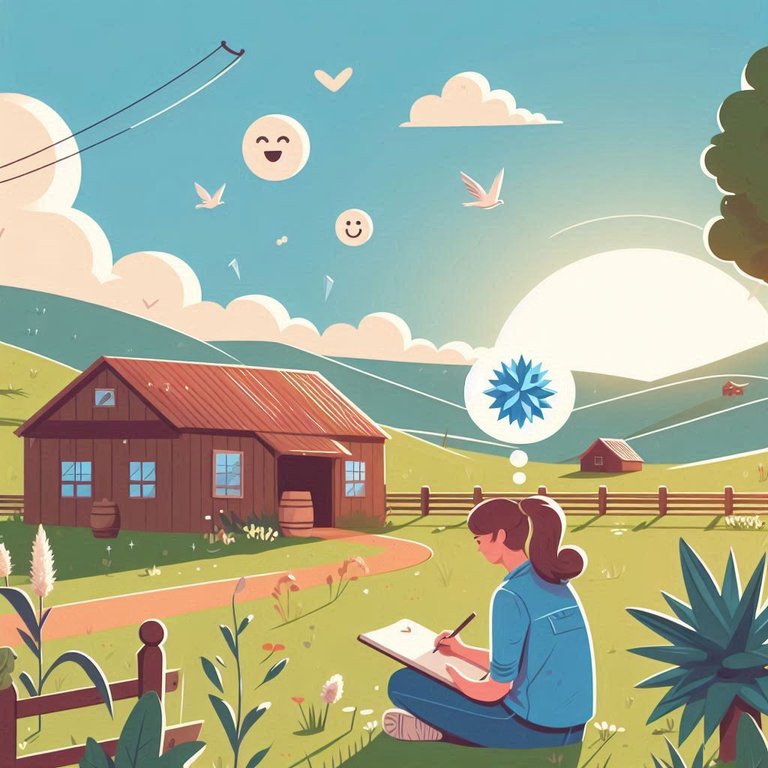
- A day to reflect: You have your Emotion Journal and have perfectly kept it for months, now it's time to review it. Start in chronological order, review your emotions, read everything you've written, use markers to highlight what you find most important. Reflect on everything you've learned and write a small summary of your most common emotions, the places that make you happiest, and the people you enjoy the most. And that's it! Now, start all over again. By now, you will have learned about your emotions. You will see that there has been real progress and you have identified patterns in your past experiences that will help you improve future ones.
My Favorite Emotion Apps
Moodpress:
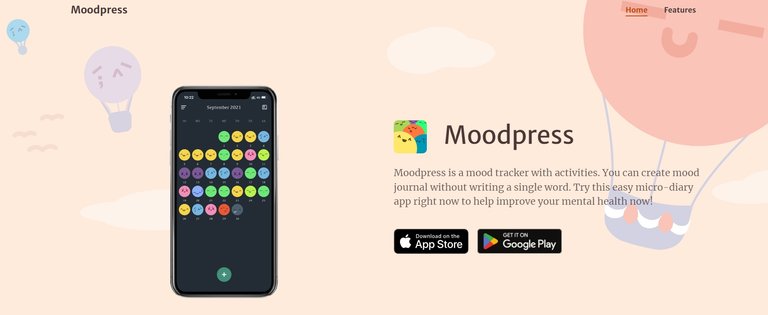
Moodpress is an app that allows you to securely record your emotions, secrets, and important photos. It offers features like password protection, mood tracking with calendars and charts, and integration with health data for a complete view of your well-being. You can also set reminders to ensure you write in your journal regularly. It's my favorite because it combines practicality with a user-friendly experience, making emotional tracking very simple.
DailyBean:
DailyBean is a visual and simple app to record your daily activities and emotions. It offers a monthly calendar that shows a summary of your mood with colorful icons and emojis, as well as weekly and monthly statistics to analyze your well-being. You can customize the category blocks according to your preferences, adding or removing what you need. It's a good option because its minimalist and visual design makes journaling easy and enjoyable.
How We Feel:
How We Feel is a free app created by scientists, designers, engineers, and therapists to help you better understand your emotions and find strategies to manage them in the moment. Based on the work of Dr. Marc Brackett and the Yale Center for Emotional Intelligence, this app helps you find the right words to describe how you feel while tracking your sleep, exercise, and health trends to identify patterns over time. Additionally, it includes step-by-step video strategies to improve your emotional well-being.
Final Words

Undoubtedly, Emotion Journals can be a tool that many underestimate, but in practice, it has proven its worth for my personal growth and emotional well-being. Whether on paper and pencil or from your phone, the most important thing is to learn about our emotions and how we react to them. It goes beyond documenting or keeping a traditional journal; it is a path to personal understanding and finding our balance both externally and internally.
I sincerely want to thank you for taking the time to read this article. Your support means a lot to me and motivates me to continue sharing content that can be useful and interesting for you. If you found this article helpful or enjoyed reading it, I would greatly appreciate your feedback. Best wishes.

Emociones y papel
Hola amigos, espero que estén teniendo un día feliz y productivo. Regreso a escribir un poco más sobre uno de los temas que me apasionan y que hace rato no tocaba: el crecimiento personal y la productividad.

Nuestro mundo cada día se mueve más rápido y todo está regido por la inmediatez y las respuestas a cientos de estímulos que llegan de todos lados. A veces, en ese vórtice veloz, olvidamos la importancia de centrarnos en nosotros mismos y en lo más olvidado: nuestras emociones. Sentarse a reflexionar sobre lo que sentimos a veces parece un lujo que no podemos costear.
Hace tiempo descubrí cómo llevar un diario de emociones y todas las bondades que esto trae consigo, por esta razón me gustaría compartirlo con ustedes. Al llevar un diario de emociones descubrí una herramienta útil para conocerme a mí mismo y cómo reacciono a los distintos estímulos del día. Además, resulta una actividad divertida que no requiere de mucho tiempo; cinco minutos serán más que suficientes.

Poco a poco irás descubriendo tus patrones, los orígenes de las emociones negativas y obteniendo mucho autoconocimiento y claridad mental. Incluso puedo asegurar que será una gran herramienta para el manejo de la ansiedad y el estrés, liberando todo lo acumulado y enfrentando las situaciones de una forma más efectiva.
Llevar un diario de emociones también nos dará un amplio dominio de las habilidades de comunicación y la forma en que damos a entender a los demás nuestros sentimientos. Fomentaremos poco a poco una gran creatividad, plasmando nuestros sentimientos en papel y abriéndonos a una nueva forma de expresión artística donde se desarrollarán ideas innovadoras.
¿Cómo llevar un diario de emociones?
Hay varias opciones para tener a mano nuestro Diario de Emociones, tanto digitales como físicas. A lo largo de este artículo trataré de cubrir ambas. Lo primero que necesitarás será una agenda y un bolígrafo si decides usar el método tradicional. Si prefieres usar un método digital, más adelante dejaré algunas recomendaciones.

Nota: Si decides usar el modo tradicional, te recomiendo que decores tu Diario de Emociones como más te guste. Puedes añadirle stickers, notas bonitas, frases, dibujar en él... Todo lo que lo haga sentir más tuyo.
- Establece un momento solo para tus emociones: Puedes empezar con poco tiempo, 5 minutos es un muy buen comienzo. Lo importante no es tanto el lugar, sino la tranquilidad para reflexionar. Horas muy recomendadas, en mi opinión, serían en las mañanas o en la noche, para tener una buena visión del resto del día.
- Describe lo que sientes: No te limites a emociones simples como feliz, triste, emocionado. Tómate tu tiempo para describir con pocas palabras cada emoción y, si reconoces los factores desencadenantes, agrégalos. Además, nombrar las actividades o el tipo de compañía en ese momento que sentiste la emoción nos puede ayudar a descubrir patrones en nuestros sentimientos.
- Honestidad: La honestidad y mantenernos abiertos y sin filtros es muy importante. Recuerda que este diario solo lo leerás tú. Permite total sinceridad mientras escribes; esta será una gran clave para entender tus emociones. No te juzgues a ti mismo en este momento y permítete fluir.
- No te centres solo en lo negativo: Uno de los principales errores que cometí cuando comencé fue centrarme solamente en las emociones negativas. Esto hacía que mi Diario de Emociones tuviera, por unos meses, el resultado contrario al que esperaba. Busca ese momento feliz del día, por muy pequeño que sea: una taza de café, un momento de relajación, una canción mientras ibas al trabajo. Esto te ayudará a tener una visión más equilibrada del día y a reflexionar sobre las cosas que de verdad tienen valor para ti. Algo que me ayudó mucho fue escribir tres cosas por las que estaba agradecido.
- Visualiza: Agrega esquemas, fotos, dibujos, garabatos; cualquier contenido visual te ayudará a fijar mejor tus emociones y crear relaciones entre ellas. Por ejemplo, pequeños doodles del clima, listas de planes, etiquetas de objetos y lugares. Trata de relacionar todo esto con tus emociones.

- Un día para reflexionar: Ya tienes tu Diario de Emociones y lo has llevado perfectamente durante meses, ahora toca el día de revisarlo. Comienza en orden cronológico, revisa tus emociones, lee todo lo que has escrito, utiliza marcadores para señalar lo que creas más importante. Reflexiona sobre todo lo aprendido y redacta un pequeño resumen de tus emociones más comunes, los lugares que te hacen más feliz y las personas que más disfrutas a tu lado. ¡Y listo! Ahora comienza todo de nuevo. Llegado a este punto habrás aprendido sobre tus emociones. Verás que ha existido un verdadero progreso y has logrado identificar patrones en tus experiencias pasadas que te ayudarán a mejorar las futuras.
Mis aplicaciones de emociones favoritas
Moodpress:

Moodpress es una aplicación que te permite registrar de forma segura tus emociones, secretos y fotos importantes. Ofrece funciones como protección por contraseña, seguimiento del estado de ánimo con calendarios y gráficos e integración con datos de salud para una visión completa de tu bienestar. También puedes configurar recordatorios para asegurarte de escribir en tu diario regularmente. Es mi favorita porque combina practicidad con una experiencia amigable, haciendo que el seguimiento emocional sea muy sencillo.
DailyBean:
DailyBean es una aplicación visual y simple para registrar tus actividades y emociones diarias. Ofrece un calendario mensual que muestra un resumen de tu estado de ánimo con íconos y emojis coloridos, además de estadísticas semanales y mensuales para analizar tu bienestar. Puedes personalizar los bloques de categorías según tus preferencias, agregando o eliminando lo que necesites. Es una buena opción porque su diseño minimalista y visual hace que llevar un diario sea fácil y agradable.
How We Feel:
How We Feel es una aplicación gratuita creada por científicos, diseñadores, ingenieros y terapeutas para ayudarte a entender mejor tus emociones y encontrar estrategias para manejarlas en el momento. Basada en el trabajo del Dr. Marc Brackett y el Centro de Inteligencia Emocional de la Universidad de Yale, esta app te ayuda a encontrar las palabras adecuadas para describir cómo te sientes mientras rastrea tu sueño, ejercicio y tendencias de salud para identificar patrones a lo largo del tiempo. Además, incluye estrategias de video paso a paso para mejorar tu bienestar emocional.
Palabras finales

Sin dudas, los Diarios de Emociones pueden llegar a ser una herramienta que muchos subestiman, pero en la práctica me ha demostrado su valía para mi crecimiento personal y bienestar emocional. Ya sea a papel y lápiz o desde tu teléfono, lo más importante es aprender sobre nuestras emociones y la forma en que reaccionamos a ellas. Va más allá de documentar o llevar un diario tradicional; es un camino al entendimiento personal y a encontrar nuestro equilibrio tanto exterior como interior.
Quiero agradecerles sinceramente por tomarse el tiempo de leer este artículo. Su apoyo significa mucho para mí y me motiva a seguir compartiendo contenido que pueda ser útil e interesante para ustedes. Si encontraron este artículo útil o disfrutaron leyéndolo, les agradecería enormemente sus comentarios. Éxitos.

| I’m Ernesto, a Cuban passionate about art and writing. Always learning, always growing. Excited to share and learn more every day! I write about art, drawing, video games, nature, and review the things I like. My goal is to inspire and connect with others through my creative journey. |
|---|
Translated with DeepL.com (free version)
I apologize if there are any grammatical errors, English is not my native language, I have tried to be as careful as possible.
I regularly create images on Pixabay, which are free of copyright. Access my gallery by clicking here.
All assets, illustrations and banners have been created by me and are original content, unless otherwise specified.
Screenshots taken by me from the official pages of the applications or stores where they are distributed, used under “Fair Use” for criticism and commentary, and are the property of their respective owners.
This article is independent and not affiliated with the application developers.
Some images in the article were generated with DALL-E 3 and are for illustrative purposes only.
Cover of the article created using Canva.
